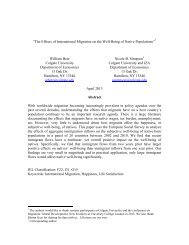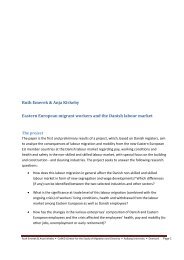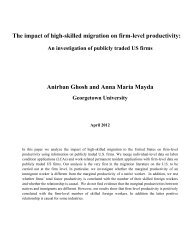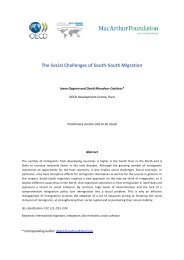The Role of Source- and Host-Country Characteristics in ... - CReAM
The Role of Source- and Host-Country Characteristics in ... - CReAM
The Role of Source- and Host-Country Characteristics in ... - CReAM
Create successful ePaper yourself
Turn your PDF publications into a flip-book with our unique Google optimized e-Paper software.
positive. As a result, the proportion <strong>of</strong> women who work <strong>in</strong> that region <strong>in</strong>creases. 5<br />
While it is not the aim <strong>of</strong> this paper to provide an empirical test <strong>of</strong> these theories,<br />
their ma<strong>in</strong> implications can be easily applied to female immigrant labor supply decisions.<br />
By observ<strong>in</strong>g other work<strong>in</strong>g women <strong>in</strong> the host country, female immigrants might change<br />
their attitudes <strong>and</strong> beliefs regard<strong>in</strong>g women’s role <strong>in</strong> the workplace <strong>and</strong> gradually adapt<br />
to the behavior <strong>of</strong> native women. <strong>The</strong> higher thereby, all else equal, the proportion <strong>of</strong><br />
work<strong>in</strong>g women <strong>in</strong> the host country, the more positive the beliefs about work <strong>and</strong> the<br />
higher the probability that an immigrant women decides to participate <strong>in</strong> the labor market.<br />
Assess<strong>in</strong>g the relationship between host-country FLFP <strong>and</strong> the labor supply <strong>of</strong> female<br />
immigrants might therefore provide some <strong>in</strong>sights <strong>in</strong>to whether immigrant women change<br />
their attitudes <strong>and</strong> beliefs <strong>and</strong> assimilate to the labor market behavior <strong>of</strong> natives.<br />
While – s<strong>in</strong>ce the sem<strong>in</strong>al work <strong>of</strong> Chiswick (1978) – a sizable body <strong>of</strong> literature has<br />
evolved that exam<strong>in</strong>es immigrant-native assimilation patterns with<strong>in</strong> a given dest<strong>in</strong>ation<br />
country, studies that analyze immigrants <strong>in</strong> different resident countries to provide evidence<br />
on the role <strong>of</strong> host-country characteristics <strong>in</strong> immigrant behavior are scarce. <strong>The</strong> only<br />
study that aims at assess<strong>in</strong>g the effect <strong>of</strong> host-country FLFP on female immigrant labor<br />
supply is Kok et al. (2011) for the Netherl<strong>and</strong>s. However, as their study is based on<br />
immigrants with<strong>in</strong> a s<strong>in</strong>gle country, their identification <strong>of</strong> the host-country effect does not<br />
rely on differences <strong>in</strong> FLFP rates between immigrants’ countries <strong>of</strong> residence, but on the<br />
difference <strong>in</strong> levels <strong>and</strong> speed <strong>of</strong> adjustment between different cohorts <strong>of</strong> immigrants. In<br />
particular, they use the <strong>in</strong>crease <strong>in</strong> the FLFP rate over successive birth cohorts <strong>of</strong> native<br />
women as a proxy for Dutch culture. <strong>The</strong> authors’ results suggests that both differences<br />
<strong>in</strong> home-country female participation <strong>and</strong> the trend <strong>in</strong> native female participation, as<br />
a measure for host-country culture, have an impact on the participation <strong>of</strong> immigrant<br />
women. <strong>The</strong> authors conclude from these results that host-country participation is at<br />
least as important as home-country participation <strong>in</strong> affect<strong>in</strong>g immigrants’ labor supply<br />
decisions.<br />
Although a positive relationship between host-country FLFP rates <strong>and</strong> immigrant<br />
women’s labor supply might be <strong>in</strong>dicative <strong>of</strong> immigrant women adapt<strong>in</strong>g to the culture <strong>of</strong><br />
the host country <strong>and</strong> therefore to the work behavior <strong>of</strong> natives, other explanations are<br />
also possible. As a given woman’s decision to participate <strong>in</strong> the labor market does not<br />
only depend on her preferences <strong>and</strong> beliefs, but also on a whole series <strong>of</strong> economic <strong>and</strong><br />
<strong>in</strong>stitutional factors that may differ across countries, FLFP at the aggregate level will not<br />
only reflect a country’s cultural environment, but its economic <strong>and</strong> <strong>in</strong>stitutional conditions<br />
5 <strong>The</strong> ma<strong>in</strong> difference between the two models lies <strong>in</strong> the assumption regard<strong>in</strong>g the driv<strong>in</strong>g force beh<strong>in</strong>d<br />
female labor supply dynamics. While Fernández (2012) assumes that women start with biased, pessimistic<br />
beliefs about work<strong>in</strong>g women which become more positive as participation rises, Fogli <strong>and</strong> Veldkamp<br />
(2011) assume that women start with unbiased beliefs, but face uncerta<strong>in</strong>ty about the effects <strong>of</strong> maternal<br />
employment on their children, which falls as <strong>in</strong>formation accumulates.<br />
6







